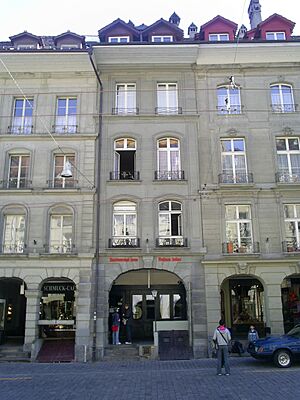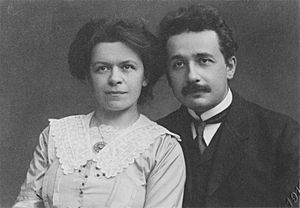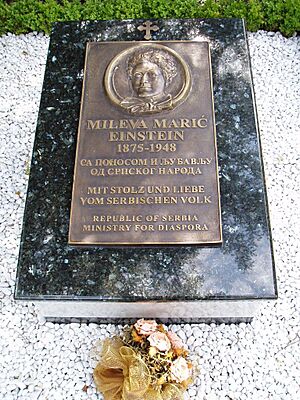Mileva Marić facts for kids
Quick facts for kids
Mileva Marić
|
|
|---|---|
| Милева Марић | |

Marić in 1896
|
|
| Born |
Mileva Marić
19 December 1875 Titel, Kingdom of Hungary, Austria-Hungary
|
| Died | 4 August 1948 (aged 72) Zürich, Switzerland
|
| Resting place | Friedhof Nordheim, Zürich |
| Nationality | Serbian |
| Other names |
|
| Alma mater |
|
| Occupation | Mathematician |
| Spouse(s) | |
| Children |
|
Mileva Marić (Serbian Cyrillic: Милева Марић; born December 19, 1875 – died August 4, 1948) was a Serbian physicist and mathematician. She was the first wife of the famous scientist Albert Einstein.
Mileva was the only woman studying with Einstein at the Zürich Polytechnic. She was also one of the first women to complete a full study program in mathematics and physics there. Mileva and Albert Einstein were friends and collaborators. They had a daughter named Lieserl in 1902, whose story is not fully known. Later, they had two sons, Hans Albert and Eduard.
Mileva and Albert separated in 1914. She moved back to Zürich with their sons. They divorced in 1919. When Albert Einstein won the Nobel Prize in 1921, he gave the prize money to Mileva. This money was mainly to help support their sons. In the 1930s, their son Eduard became ill. To pay for his care, Mileva had to sell some of the houses she and Albert had bought.
Contents
Early Life and Education
Mileva Marić was born on December 19, 1875, in Titel, which was part of Austria-Hungary (now Serbia). She came from a wealthy family and was the oldest of three children. Her father, Miloš Marić, worked at a court.
Mileva started high school in 1886. She was very good at math and physics. In 1891, her father got special permission for her to attend an all-boys high school in Zagreb. This was unusual for a girl at that time. She passed her exams with high grades in math and physics.
In 1894, Mileva moved to Switzerland. She started at a girls' high school in Zurich. In 1896, she passed her final exams and briefly studied medicine at the University of Zurich.
Studying at Polytechnic
In the fall of 1896, Mileva joined the Zurich Polytechnic (now called ETH). She enrolled in a program to become a physics and math teacher for high schools. Albert Einstein was in the same class. Mileva was the only woman in their group of six students. She was also only the fifth woman ever to join that section. This shows she was very talented to get accepted. She and Einstein quickly became close friends.
Mileva took a break in 1897 to study at Heidelberg University for one semester. She returned to Zurich Polytechnic in April 1898. Her studies included many advanced math and physics courses.
She took her intermediate exams in 1899. Her grades were good, especially in physics. However, in 1900, she failed her final teaching exams. She tried again in 1901 but failed a second time. This happened when she was pregnant with Einstein's child. She then stopped working on her diploma project.
Birth of Lieserl
Mileva became pregnant with Albert Einstein's child in 1901. She went to her hometown to give birth in secret. Their daughter, Lieserl, was born in January 1902 in Novi Sad. There is not much information about what happened to Lieserl after that. Some believe she died young, while others think she was given up for adoption.
Debate About Her Contributions
There is a discussion among historians about whether Mileva Marić helped Albert Einstein with his early scientific work. Some historians believe she did not make major scientific contributions. Others suggest she was a supportive partner in science and might have helped him with his research. There is also a possibility they developed ideas together when they were students.
Arguments for Collaboration
Some people who believe Mileva contributed point to a few things:
- A Russian physicist named Abram Joffe wrote that some important papers from 1905 were by "Einstein-Marity." Marity was Mileva's maiden name. This made some wonder if her name was on the papers, or if Joffe thought she was a co-author.
- Mileva reportedly told a friend in Serbia that "we finished some important work that will make my husband world famous."
Arguments Against Collaboration
Other historians argue against her direct scientific contribution:
- They say that Joffe might have been mistaken about the name "Einstein-Marity."
- They point out that in letters from their student days, Einstein sometimes used "our" when talking about their studies. However, when he talked about his specific ideas for his famous papers, he usually used "I" and "my."
- Mileva's own letters mostly focused on personal matters or her coursework, not deep scientific discussions.
- Some scholars say there is no strong evidence, like published papers or detailed scientific letters from her, to show she developed theories herself.
Family Accounts
Despite the academic debate, some family members remember them working together:
- Mileva's brother and other relatives said they saw Mileva and Albert discussing physics when they were married.
- Their first son, Hans Albert, said that his mother gave up her own science goals after marrying. But he also remembered his parents working together on science at the same table in the evenings.
Marriage and Family Life
Mileva Marić and Albert Einstein married in 1903 in Bern, Switzerland. Albert had found a job at the Swiss Patent Office there.
Their first son, Hans Albert, was born in 1904. The family lived in Bern until 1909. Then, Albert got a teaching job at the University of Zürich. In 1910, their second son, Eduard, was born. The family moved a few times for Albert's work, living in Prague and then returning to Zurich.
Moving to Berlin and Separation
In 1913, Albert Einstein was invited to work in Berlin. Mileva was not happy about this move. In March 1914, the family moved to Berlin.
Their marriage had become difficult. In July 1914, Albert set strict rules for Mileva if she wanted to stay with him. She decided not to accept these terms. On July 29, 1914, just after World War I began, Mileva left Berlin with her sons and returned to Zürich. This separation became permanent.
They divorced on February 14, 1919. They agreed that the Nobel Prize money Albert expected to receive would be put into a trust fund for their two sons. Mileva could use the interest from this money.
In 1922, Albert Einstein won the Nobel Prize. As agreed, the money went to Mileva for their sons. Mileva used some of the money to buy three apartment buildings in Zurich. She lived in one of them, and the other two were investments.
In 1930, their son Eduard became very ill and was diagnosed with schizophrenia. By the late 1930s, the cost of his care was very high. Mileva sold two of the houses to pay for his medical expenses.
Death
Mileva Marić had a severe stroke and passed away on August 4, 1948, in Zürich, at the age of 72. She was buried in the Nordheim-Cemetery in Zürich. Her son Eduard remained in institutional care until his death in 1965.
Honours
Mileva Marić has been honored in several ways:
- In 2005, a memorial plaque was placed on her former home in Zürich.
- Busts (statues of her head and shoulders) were placed in her high-school town, Sremska Mitrovica, and on the campus of the University of Novi Sad.
- A high school in her birthplace of Titel is named after her.
- In 2009, a memorial gravestone was dedicated to her at the Nordheim-Cemetery in Zürich.
Her life has also been featured in books and plays:
- A book about her, Mileva Marić Ajnštajn, was published in Serbia in 1995.
- A play called Mileva Ajnštajn was written in 1998 and later turned into an opera.
In Popular Culture
Mileva Marić's life has been shown in various forms of popular culture:
- The novel The Other Einstein (2016) by Marie Benedict tells a fictional story about her relationship with Albert Einstein.
- In 2017, she was featured in the first season of the TV series Genius, which was about Einstein's life.
- A fictional version of Mileva Marić appeared in an episode of the superhero TV series, DC's Legends of Tomorrow.
- In 2019, a physicist asked the ETH to give Mileva Marić a degree after her death, but the university said no.
- Mileva Marić is an important character in Margaret Peterson Haddix's 2012 young-adult science-fiction novel Caught.
See also
 In Spanish: Mileva Marić para niños
In Spanish: Mileva Marić para niños
- Relativity priority dispute
- Miloš Marić (scientist)





